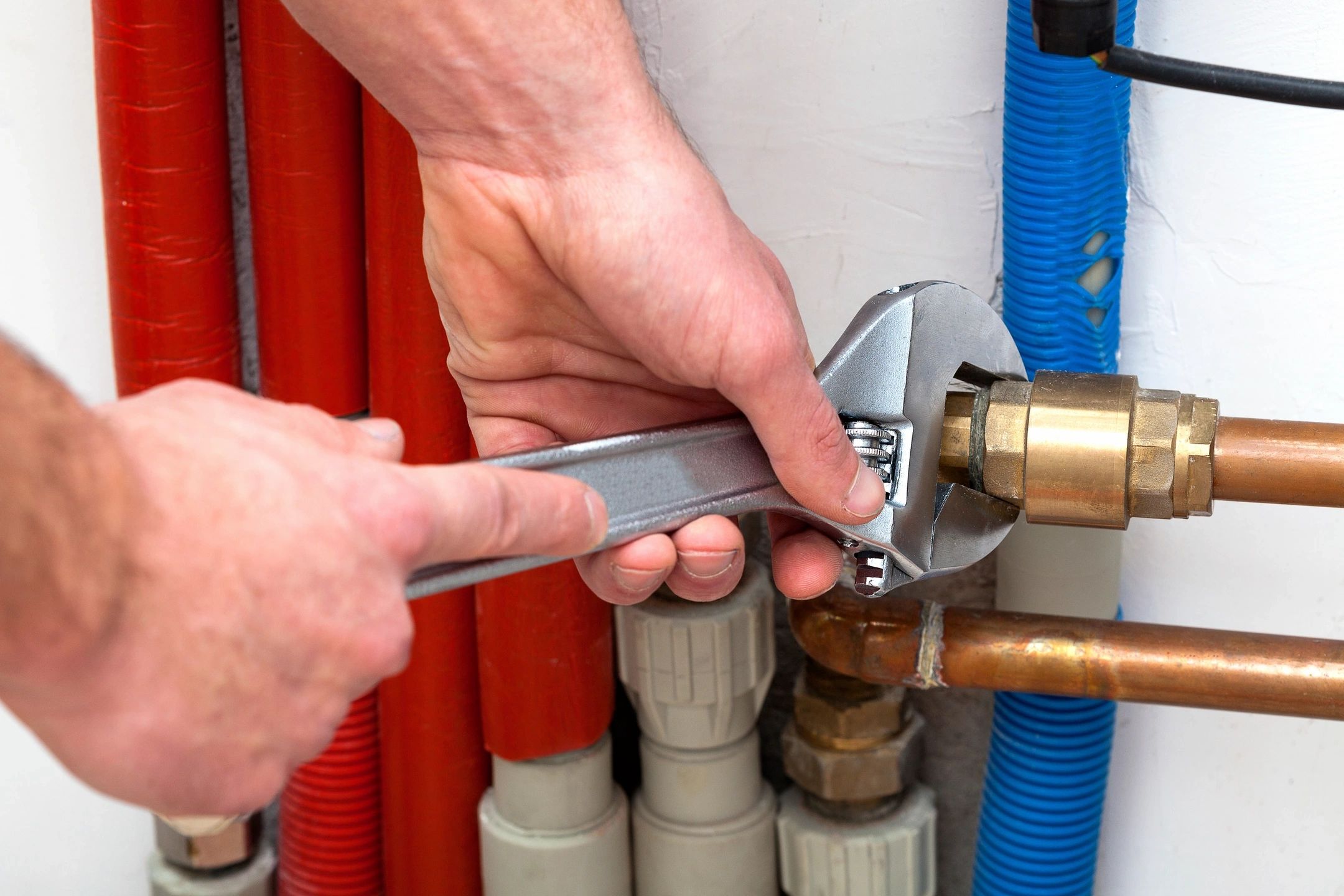
A decade’s worth of neglected maintenance and underfunding, paired with rapid growth and unprecedented demographic change, has left Spotsylvania County’s school system crippled, and facing an uncertain future.
by Martin Davis
EDITOR-IN-CHIEF
Down in the bowels of Chancellor Middle School sits a relic from 1987. A roughly six-foot tall metal box with rows of black fuse boxes that run on fuses no longer commercially available. Then there are the boilers—some rusting—that have seen better days.
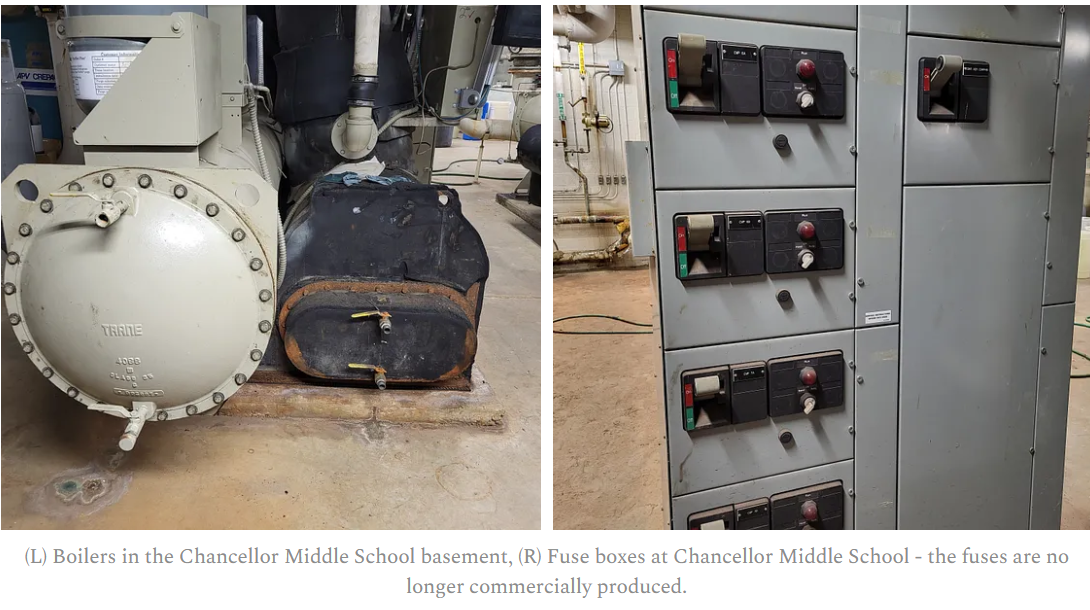
Should one of these boilers fail—as recently happened at Rodney Thompson Middle School in Stafford—it would close not only Chancellor Middle, but Chancellor High School as well. For an indeterminate amount of time. That leaves 2,150 students with no school to attend, and no easy solutions for housing them elsewhere while a solution is found.
That’s a worst-case scenario. The day-to-day realities are every bit as challenging.
The system does a poor job of regulating humidity in the school, which has led to warped ceiling tiles that ideally should be replaced.
Worse still, this highly inefficient system is draining precious dollars away from the school district.
These two schools are far from the only facilities facing these challenges.
School Board member Nicole Cole recently took FXBG Advance on a tour of five of the district’s schools—Chancellor High School and Middle School, Parkside Elementary, Spotswood Elementary, Spotsylvania Middle, and the Spotsylvania Career and Technical Center.
These schools are the front lines of the substantial challenges the district faces as it prepares to receive an ever-growing number of diverse students.
Special education, a surging number of English Language learners, and demand for more technical education are stressing a system that is both struggling due to years of underfunding and aging buildings. The last new school built in Spotsylvania? Cedar Forest Elementary—in 2008.
State of the Physical Facilities
The average age of Spotsylvania’s schools is 39 years, and many are showing the wear-and-tear that comes with continuous use and little preventative maintenance.
While the district has a maintenance staff of 54 employees, there is no dedicated preventative maintenance staff. Instead, skilled trades people like HVAC technicians, electricians, and plumbers must handle this work on top of their other duties—a poor use of their time. Further, taking care of these older buildings is no part-time, fill-in-the-gap task.
Consider Spotsylvania Middle School, which currently has nearly 200 filters that must be changed monthly. Multiply that number by 31 schools, and one gets some sense of the scope of the problem. Failure to do this maintenance regularly exasperates the efficiency problems with the aging HVAC system at a school like Chancellor Middle and drives electrical costs ever higher. This at a time when the need to recruit, retain, and properly outfit classrooms and teachers to do their jobs is everyone’s number one concern.
How much money does the district spend on electricity? North of $6 million a year. At Chancellor Middle School and High School, which share the same HVAC system, the bill run about $35,000 a month.
On average, a school’s HVAC system has a lifespan of between 25 and 30 years. This means that the district should be replacing about one system annually. Over the past eight years, only three systems have been replaced. A fourth replacement is currently underway at Riverview Elementary School that should be completed this June.
Energy is far from the only issue, however. At Spotswood Elementary School, the roof will soon need to be replaced. The cost to do this will be at least $1.5 million, and probably considerably more. Further, the school’s drainage and plumbing systems are in need of significant upgrades. How significant is hard to quantify.
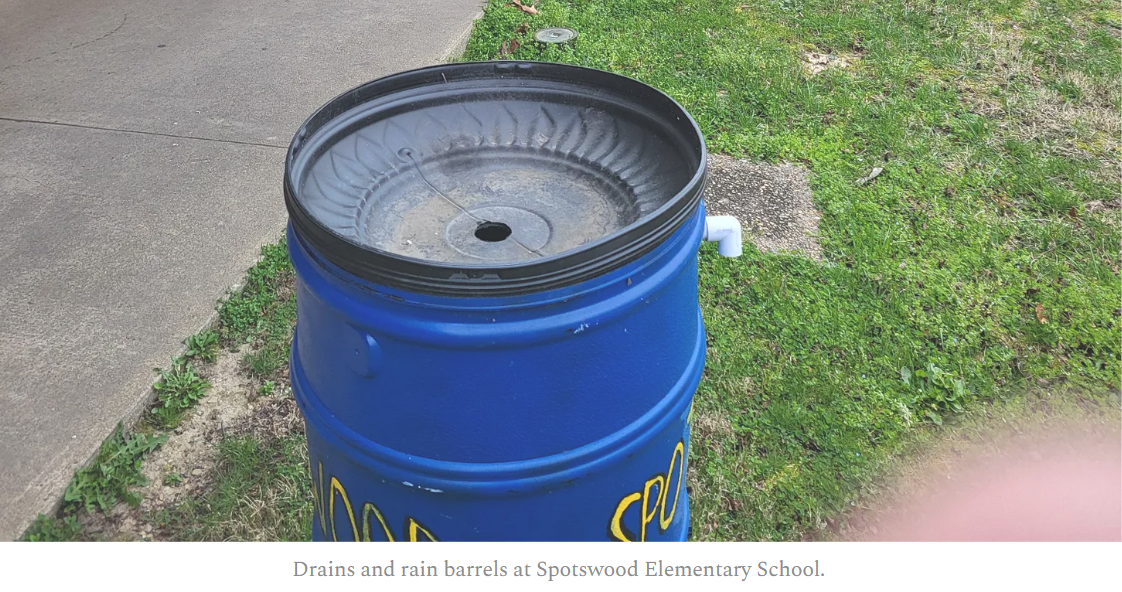
At Parkside Elementary, modular units that contain up to 10 classrooms per unit, as well as a restroom and drinking fountain, are now being used to handle the overflow of students—the school is currently 60 students over capacity. These modular units themselves are of high quality and defy the stereotypes of “trailers,” but they are neither cheap nor easy to maintain.
To install one modular classroom requires about $500,000 to cover site preparation, utilities, and safety and security measures. Altogether, there are six modular units in use in the district—one at Parkside, three at Massaponax High School, and two at Spotsylvania Middle School.
The exact amount of repair work that needs to be done to facilities in the district is not currently known. That’s why the division is putting out a request for proposals for an engineering firm to do an assessment of the existing mechanical, electrical, plumbing, and roofing conditions, and prioritize the repairs that demand the greatest attention.
When this assessment is completed in 2025, the district will finally have a clear understanding of the work that needs to be done as it prepares to plan its next CIP.
Even where progress is being made, the district is struggling to meet all the needs of its buildings.
Spotsylvania Middle School is currently undergoing a significant upgrade, with expanded capacity, a new cafeteria, and innovative spaces that allow for collaborative educational opportunities between classes.
However, the upgrades do not include improvements to the library, clinic, main office, auditorium, gym, or the performing arts area which is currently too small and dark.
To cover these, the district has asked that $20 million be added to the CIP to cover these costs.
Even the Bright Spots Have Shadows
The problems with facilities go well beyond long-overdue repairs, however.
One of the district’s more-successful schools is the Spotsylvania Career and Technical Center located adjacent to Courtland High School. Students from each of the district’s six high schools attend and are trained in a wide range of technical areas that equip them to enter the job market immediately after high school.
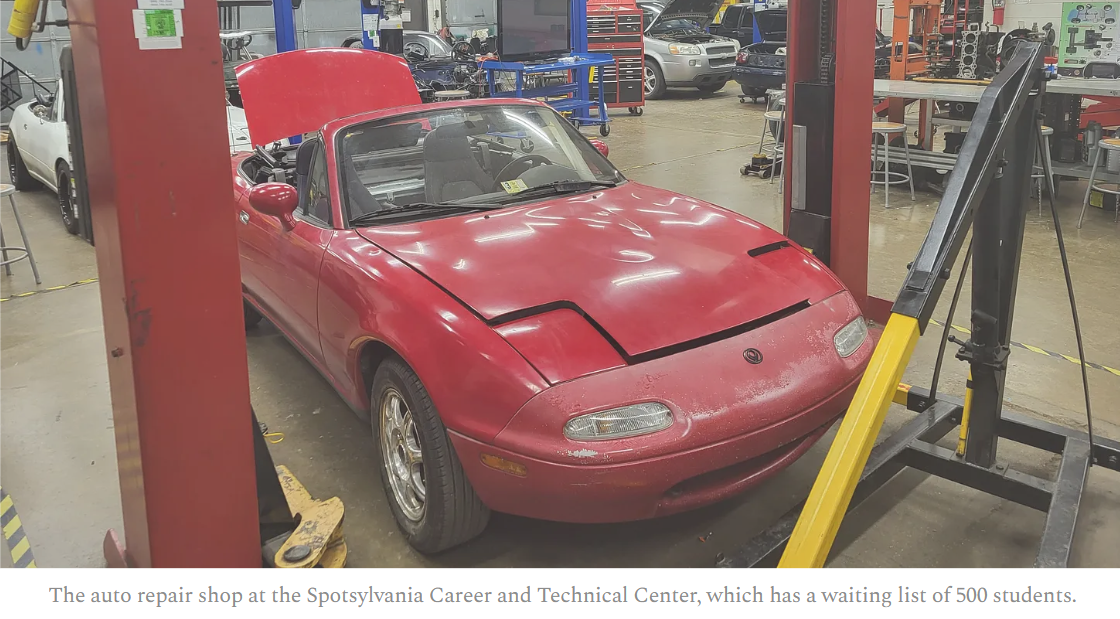
Currently, the school has about 1,300 students. However, there’s a waiting list of some 500 students who want to take advantage of these programs but cannot because space is not available.
The only real solution here is to build another facility—an exceptionally expensive proposition.
Politically speaking, this is a relatively easy sell. Technical education is popular right now. With a demonstrated interest in offering more classes, voters are more likely to support the bond issue that would have to underwrite that project.
A Harder Sell
Convincing the public to build new buildings for overcrowding in nontechnical schools can be a tougher sell.
Of the schools the Advance visited, Chancellor Middle and Parkside Elementary are both over their capacity. Chancellor High School is nearly at capacity. And the new Spotsylvania Middle School will be within about 80 students of hitting its capacity when it opens.
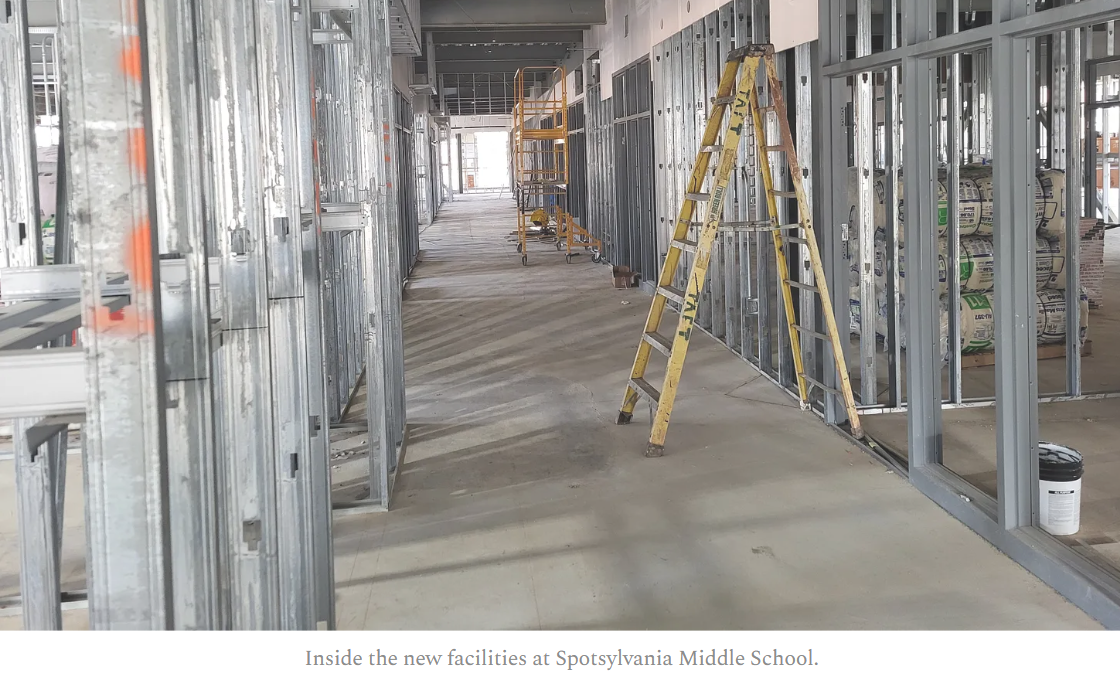
The challenge of meeting these capacity needs, however, is not as simple as redistricting or increasing class size. That’s because when it comes to putting children in the classroom, one has to consider more than the number of children who can fit in a room. You have to consider the specific needs of students.
According to the presentation that Phil Trayer, the school division’s chief financial officer, gave in December, the number of students identified as needing special education has soared from 2,623 in the 2012-2013 school year, to more than 3,700 in the 2023-2024 school year.
Accommodating these students can lower the overall capacity of a school. How?
Here’s a simple way to think about that.
If a school has 10 classrooms designed to hold 30 students each, the school will have a total capacity of 300 students.
Now, consider that if 10% of those students have disabilities that don’t permit them to be integrated into regular classrooms, it’s impossible to fit 30 of these students in one room. The appropriate capacity for these students may be, for example, 15 students per class.
This would reduce the capacity of two of the 10 classes from 30 students each to 15.
The result?
The school now has eight classes that can hold 30 students each, for a total of 240 students. And two classes that can hold 15 each, for a total of 30 students.
Thus, the overall capacity of the school has been reduced from 300 to 270.
Yes, More Money is the Solution
Underfunding schools in Spotsylvania is not a new phenomenon. And few have been more critical of the Board of Supervisors for failing to adequately fund schools than Supervisor Chris Yakabouski.
“It’s frustrating,” he told the Advance. “I’ve been talking about this for 10 years.”
At this point, Yakabouski argues, it should be obvious that this pleading for more funds is not a political ploy.
“At some point,” he said, “you have to fund the schools.”
What the Board of Supervisors has been funding over the past several years has been fire and rescue and police.
“In the past,” Yakabouski told the Advance in February, [the money to pay for these upgrades] “came out of the typical transfer that would have gone for schools. And now the school system has told us over the past two Boards that we need more revenue. So either something has to be cut, or you increase the rate to cover the cost.”
Still, he also says that he was surprised by the maintenance needs and costs to repair them.
“When we saw that list,” he told the Advance, “it was distressing that it wasn’t provided earlier.”
Instead, he said, the focus has always been on funds for the teachers and the kids in the classroom.
“Deferred maintenance—I don’t remember it being an issue that was at the front of the discussion at all.”
The question of why the Board of Supervisors wasn’t made aware of the school division’s maintenance needs is a secondary one at this time, however.
The reality at this moment is that the school district is looking at a significant shortfall in funding that is going to profoundly impact students’ learning, both because of the deteriorating conditions of the buildings, and the changing demographics that are affecting school capacity.
Sometimes, money is the answer.




